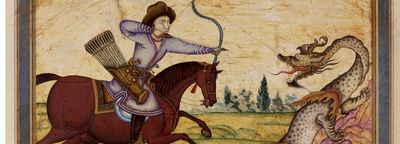The event, slated for March 15-24, is presented by leading international Asian art specialists, major auction houses and world-renowned museums and cultural institutions.
As part of the event, Francesca Galloway Art Gallery is displaying 32 folios illustrated with detailed colorful paintings under the title 'Persian and Indian Court Paintings'. Of the total works, nine have an Iranian origin.
One of the folios, a painting, depicts Bahram Gur (the 15th king of Sassanid Empire, ruling from 420 to 438) taking aim at an open-mouthed dragon. According to the events catalogue, it probably served as an illustration to 'Haft Peykar' (seven beauties), a medieval romance by Persian poet Nizami Ganjavi (1141-1209), which describes how the hero Bahram Gur was asked to save a favorite horse of a princess by slaying a fearsome dragon. The work is attributed to Muhammad Paolo Zaman Kirmani known as Muhammad Zaman, a famous Safavid calligrapher and painter. Zaman was familiar with the scene and had produced several related versions.
Another work attributed to Iranian artists is an illustration from Shahnameh (The Great Book), an epic poem by celebrated Persian poet Ferdowsi (940-1020). Named 'Gushtasp Plays Polo Before Caesar', the work is estimated to have been created in the second half of the 16th century. It has opaque pigments heightened with gold on paper, with seven lines of black Nastaliq script above and one below, set in white clouds.
Gushtasp, the Iranian prince, travels incognito to the west hearing of the great beauty of the daughter of Roman Emperor. He performs several feats before the Roman emperor to win the hand of his daughter. The scene depicts the prince, dressed in all his glory, wearing a crown with three plumes just about to strike the large rosette-shaped ball and score a goal. The Roman Emperor, who is wearing similar imperial regalia to Gushtasp is observing the scene from above. The detail of the musicians energetically playing the drums and blowing long horns give a great sense of atmosphere to what is depicted as a fast-paced and exciting sporting match, the catalogue says.
Gallery of Oliver Forge & Brendan Lynch
New York- and London-based Gallery of Oliver Forge & Brendan Lynch Ltd. is also presenting a selection of Indian and Persian court paintings in its New York branch. Oliver Forge and Brendan Lynch are independent art dealers specializing in Indian and Asian arts, as well as Ancient Greek, Roman and Egyptian.
According to the catalogue published by the gallery, on show are 35 paintings, including two works of Iranian origin: one is 'A Master and His Pupil', circa 1650, a drawing in ink with some color on paper attributed to Iranian painter and illustrator Muhammad Qasim.
Laid down in an album page with gilt animals and birds amid foliage on a green ground and blue border, the work has two panels of appliqué Nastaliq above, containing a verse from 'Boustan' (The Orchard) by renowned 13th-century Persian poet Sa’di.
Qasim was a leading artist in the court of Shah Abbas II (reigning over Iran during 1642-66). He is thought to have been active in Mashhad and Isfahan in the first half of the century. He specialized in portraits of fashionable youths. The hallmarks of his style include the pronounced roundness of the youths’ faces, stippling of the ground, billowing clouds and a restrained palette often with touches of red, the catalogue says.
Another work of Iranian origin on display is a finely-illuminated leaf from a Safavid or Mughal Shahnameh manuscript. The page has 25 lines of black Nastaliq in ink within clouds set against a gold ground. It is written in four columns and has elaborately illuminated borders.
The wide margin of the page, better not to be called margin as it covers a greater part of the page, has a glowing ultramarine background adorned with pairs of leaves, each composed of three saber-like crescents that are bitten by a variety of brilliantly conceived animal heads, including scroll-headed dragons, rabbits, hares, foxes and wolves. Alternating with them are human faces, each with slender eyes, rosebud lips and wisps of hair.
Source: Financial Tribune

